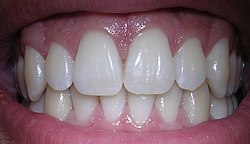| Human tooth | |
|---|---|
 | |
 Diagram of a human molar showing its major constituents | |
| Details | |
| Identifiers | |
| Latin | dens |
| TA2 | 914 |
| Anatomical terminology | |
Human teeth function to mechanically break down items of food by cutting and crushing them in preparation for swallowing and digesting. As such, they are considered part of the human digestive system.[1] Humans have four types of teeth: incisors, canines, premolars, and molars, which each have a specific function. The incisors cut the food, the canines tear the food and the molars and premolars crush the food. The roots of teeth are embedded in the maxilla (upper jaw) or the mandible (lower jaw) and are covered by gums. Teeth are made of multiple tissues of varying density and hardness.
Humans, like most other mammals, are diphyodont, meaning that they develop two sets of teeth. The first set, deciduous teeth, also called "primary teeth", "baby teeth", or "milk teeth", normally eventually contains 20 teeth. Primary teeth typically start to appear ("erupt") around six months of age and this may be distracting and/or painful for the infant. However, some babies are born with one or more visible teeth, known as neonatal teeth or "natal teeth".
- ^ Stay, Flora. "How Your Teeth Affect Your Digestive System". TotalHealth Magazine. Archived from the original on 18 December 2023. Retrieved 27 August 2022.